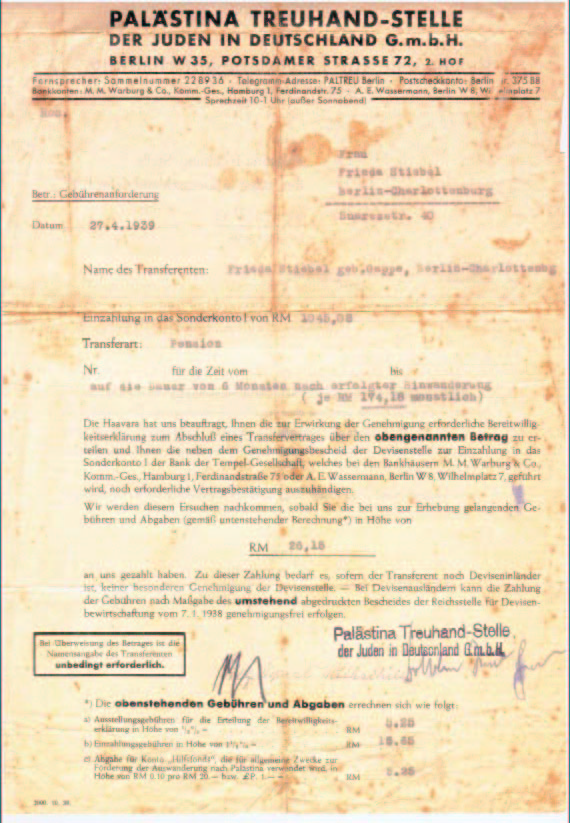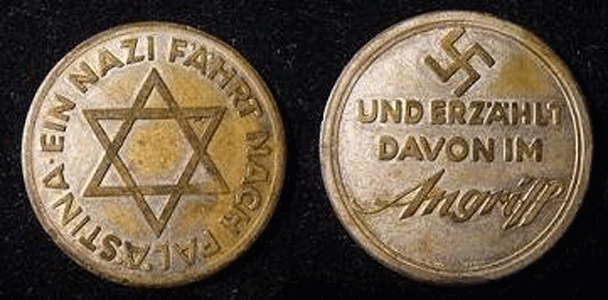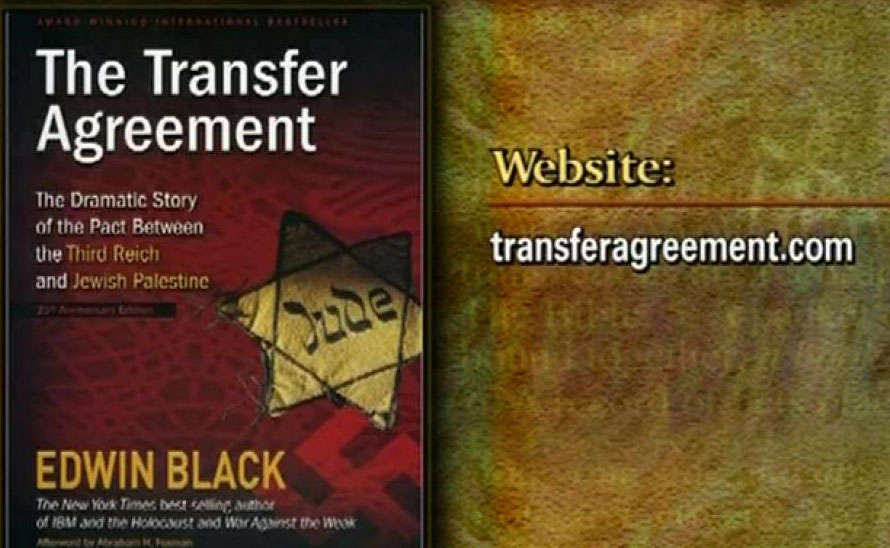
Christian Zionism – part 5
The Zionist 1933 Agreement with Nazi Germany
Whilst the whole world of Jews united in one voice in the 1930’s to sanction and boycott Germany and their goods, a small group of ambitious Zionist Jews in Germany negotiated and entered into an agreement with Nazi Germans. This agreement would eventually enable 60 000 Jews to leave Germany and relocate to Palestine together with all their wealth.
Details of this agreement, called the ‘Haavara'(Ha Avara) are widely recorded in Jewish archives. Very little was however mentioned in the media about this arrangement until a Jewish author, Edwin Black, engaged in a massive research project into the archives of history which resulted in his controversial book entitled – ‘The Transfer Agreement’.
This agreement between the Jewish Zionists and the Nazis resulted in a much desired (by the Zionsists) exodus of both Jewish people and wealth into Palestine during the 1930’s and 1940’s.
Edwin Black came from a family of Holocaust survivors and the initial reaction of his parents to his book was to disown him as their son. They did however change their minds once details of the ‘Haavara’ were explained to them.
What must be understood though is that the broader Jewish community across the world were opposed to this Zionist arrangement with the Nazis.
It was the mention of this ‘agreement’ that led to the ex London mayor Ken Livingstone being branded an ‘antisemite’. One needs to ask why stating a fact from history would lead to such an aggressive character attack.
You read the content below and decide for yourself who would want to suppress this detail of history and why. It is certainly not a proud event in Jewish history.
What the agreement did achieve was to boost the Jewish population and the Jewish wealth in Palestine at the time.
In this post:
Video 1 – Edwin Black The Transfer Agreement
Video 2 – The Transfer Agreement/ Haavara Agreement – Zionists & The Nazi Party
Books:
The Transfer Agreement – Author – Edwin Black
51 Documents – Zionist Collaboration With The Nazis – Author – Lenni Brenner
Zionism In the Age of Dictators – Author – Lenni Brenner
The Haavara Agreement -1933
From Wikipedia, the free encyclopedia
The Haavara Agreement (Hebrew: הֶסְכֵּם הַעֲבָרָה Translit.: heskem haavara Translated: “transfer agreement”) was an agreement between Nazi Germany and Zionist German Jews signed on 25 August 1933. The agreement was finalized after three months of talks by the Zionist Federation of Germany, the Anglo-Palestine Bank (under the directive of the Jewish Agency) and the economic authorities of Nazi Germany. It was a major factor in making possible the migration of approximately 60,000 German Jews to Palestine in 1933–1939.
The agreement enabled Jews fleeing persecution under the new Nazi regime to transfer some portion of their assets to British Mandatory Palestine. Emigrants sold their assets in Germany to pay for essential goods (manufactured in Germany) to be shipped to Mandatory Palestine. The agreement was controversial at the time, and was criticised by many Jewish leaders both within the Zionist movement (such as the Revisionist Zionist leader Ze’ev Jabotinsky) and outside it, as well as by members of the NSDAP and members of the German public. For German Jews, the agreement offered a way to leave an increasingly hostile environment in Germany; for the Yishuv, the new Jewish community in Palestine, it offered access to both immigrant labor and economic support; for the Germans it facilitated the emigration of German Jews while breaking the anti-Nazi boycott of 1933, which had mass support among European Jews and was thought by the German state to be a potential threat to the German economy.
Background
Although the NSDAP won the greatest share of the popular vote in the two Reichstag general elections of 1932, they did not have a majority, so Hitler led a short-lived coalition government formed by the NSDAP and the German National People’s Party. Under pressure from politicians, industrialists and others, President Paul von Hindenburg appointed Hitler as Chancellor of Germany on 30 January 1933. This event is known as the Machtergreifung (seizure of power).[7] In the following months, the NSDAP used a process termed Gleichschaltung (co-ordination) to consolidate power. By June 1933, virtually the only organisations not under the control of the NSDAP were the army and the churches.
Within the Nazi movement, a variety of (increasingly radical) “solutions” to the “Jewish Question” were proposed both before and after the NSDAP was in government, including expulsion and the encouragement of voluntary emigration. Widespread civil persecution of German Jews began as soon as the NSDAP was in power. For example, on 1 April, the NSDAP organized a nationwide boycott of Jewish-owned businesses in Germany; under the Law for the Restoration of the Professional Civil Service which was implemented on 7 April, Jews were excluded from the civil service; on 25 April, quotas were imposed on the number of Jews in schools and universities. Jews outside Germany responded to these persecutions with a boycott of German goods.
Meanwhile, in Mandatory Palestine, a growing Jewish population (174,610 in 1931, rising to 384,078 in 1936) was acquiring land and developing the structures of a future Jewish state despite opposition from the Arab population.
Hanotea company
Hanotea (הַנּוֹטֵעַ, “the Planter”) was a citrus planting company based in Netanya and established in 1929 by long-established Jewish settlers in Palestine involved in the Benei Binyamin movement. In a deal worked out with the Reich Economics Ministry, the blocked German bank accounts of prospective immigrants would be unblocked and funds from them used by Hanotea to buy agricultural German goods; these goods, along with the immigrants, would then be shipped to Palestine, and the immigrants would be granted a house or citrus plantation by the company to the same value.[14] Hanotea’s director, Sam Cohen, represented the company in direct negotiation with the Reich Economics Ministry beginning in March 1933. In May 1933 Hanotea applied for permission to transfer capital from Germany to Palestine.This pilot arrangement appeared to be operating successfully,[citation needed] and so paved the way for the later Haavara Agreement.
The transfer agreement
The Haavara (Transfer) Agreement, negotiated by Eliezer Hoofein, director of the Anglo-Palestine Bank, was agreed to by the Reich Economics Ministry in 1933, and continued, with declining German government support, until it was wound up in 1939.Under the agreement, Jews emigrating from Germany could use their assets to purchase German-manufactured goods for export, thus salvaging their personal assets during emigration. The agreement provided a substantial export market for German factories to British-ruled Palestine. Between November, 1933, and 31 December 1937, 77,800,000 Reichmarks, or $22,500,000, (values in 1938 currency) worth of goods were exported to Jewish businesses in Palestine under the program.[17] By the time the program ended with the start of World War II, the total had risen to 105,000,000 marks (about $35,000,000, 1939 values).
Emigrants with capital of £1,000, (about $5,000 in 1930s currency value) could move to Palestine in spite of severe British restrictions on Jewish immigration under an immigrant investor program similar to the modern EB-5 visa. Under the Transfer Agreement, about 39% of an emigrant’s funds were given to Jewish communal economic development projects, leaving individuals with about 43% of the funds.
The Haavara Agreement was thought among some German circles to be a possible way to solve the “Jewish problem.” The head of the Middle Eastern division of the foreign ministry, the anti-NSDAP politician Werner Otto von Hentig, supported the policy of settling Jews in Palestine. Hentig believed that if the Jewish population was concentrated in a single foreign entity, then foreign diplomatic policy and containment of the Jews would become easier.[21] Hitler’s own support of the Haavara Agreement was unclear and varied throughout the 1930s. Initially, Hitler seemed indifferent to the economic details of the plan, but he supported it in the period from September 1937 to 1939.
After the German invasion of Poland in September 1939 the program was ended.
Example of the certificate issued by Haavara to Jews emigrating to Palestine
“ CERTIFICATE
The Trust and Transfer Office “Haavara” Ltd. places at the disposal of the Banks in Palestine amounts in Reichmarks which have been put at its disposal by the Jewish immigrants from Germany. The Banks avail themselves of these amounts in Reichmarks in order to make payments on behalf of Palestinian merchants for goods imported by them from Germany. The merchants pay in the value of the goods to the Banks and the “Haavara” Ltd. pays the countervalue to the Jewish immigrants from Germany. To the same extent that local merchants will make use of this arrangement, the import of German goods will serve to withdraw Jewish capital from Germany.
The Trust and Transfer Office,
HAAVARA, LTD. ”
Responses
The agreement was controversial both within the NSDAP and in the Zionist movement. As historian Edwin Black put it, “The Transfer Agreement tore the Jewish world apart, turning leader against leader, threatening rebellion and even assassination.” Opposition came in particular from the mainstream US leadership of the World Zionist Congress, in particular Abba Hillel Silver and American Jewish Congress president Rabbi Stephen Wise.Wise and other leaders of the Anti-Nazi boycott of 1933 argued against the agreement, narrowly failing to persuade the Nineteenth Zionist Congress in August 1935 to vote against it.
The right-wing Revisionist Zionists and their leader Vladimir Jabotinsky were even more vocal in their opposition. The Revisionist newspaper in Palestine, Hazit Haam published a sharp denunciation of those involved in the agreement as “betrayers”, and shortly afterwards one of the negotiators, Haim Arlosoroff was assassinated.
Transfer agreement used by the Palästina Treuhandstelle (Palestine Trustee Office[12]), established specifically to assist Jews fleeing the Nazi regime to recover some portion of the assets they had been forced to surrender when they fled Nazi Germany.

Jewish Virtual Library – from Encyclopedia Judaica: Haavara
HAAVARA, a company for the transfer of Jewish property from Nazi Germany to Palestine. The Trust and Transfer Office Haavara Ltd., was established in Tel Aviv, following an agreement with the German government in August 1933, to facilitate the emigration of Jews to Palestine by allowing the transfer of their capital in the form of German export goods. The Haavara Agreement is an instance where the question of Jewish rights, Zionist needs and individual rescue were in deep tension. Jewish organizations outside of Germany had declared a boycott against German goods and hoped to delegitimate the Nazi regime.
The Zionists saw this agreement as a way of attracting Jews to Palestine and thus rescuing them from the Nazi universe even if that meant cooperation with Hitler. For a time the Nazi program of making Germany Judenrein and the Zionist policy of seeking olim coincided. The amounts to be transferred were paid by prospective emigrants into the account of a Jewish trust company (PALTREU – Palestina Treuhandstelle zur Beratung deutscher Juden) in Germany and used for the purchase of goods, which the Haavara then sold in Palestine. The proceeds, in Palestine currency, were paid to the emigrants living in Palestine. The rate of exchange was adjusted from time to time by the Haavara according to the disagio, necessitated by the subsidy which the Haavara granted the Palestinian importers, to make up for the steadily deteriorating value of the Reich mark, so the German goods could compete with other imports. The ensuing disagio, borne by the emigrants, accordingly increased from 6% in 1934 to 50% in 1938.
The major part of the transfer proceeds provided the 1,000 Palestine Pounds (then $4,990) necessary for a “capitalist” immigration certificate of the Mandatory administration, but also for other categories of immigration, such as Youth Aliyah, students, and artisans as well as for the transfer of public funds. The transfer weakened the boycott of German goods declared by many Jewish organizations around the world, and thus met with considerable opposition. The controversy was settled at the Zionist Congress in Lucerne (1935) which decided by a vast majority in favor of the transfer and placed the Haavara under the supervision of the *Jewish Agency .
The Zionists sought to attract immigrants to Palestine, most especially the affluent German Jewish immigrants and the Germans sought to get rid of their Jews, increase their exports and a propaganda victory by dividing the Jews regarding the boycott. The Haavara continued to function until World War II, in spite of vigorous attempts by the Nazi Party to stop or curtail its activities. The total transfer amounted to LP 8,100,000 (Palestine Pounds; then $40,419,000) including LP 2,600,000 (then $13,774,000) provided by the German Reichsbank in coordination with Haavara. The Haavara transfer was a major factor in making possible the immigration of approximately 60,000 German Jews to Palestine in the years 1933–1939, and together with the money invested by the immigrants themselves, in providing an incentive for the expansion of agricultural settlement and for general economic development. It also served as a model for a similar arrangement with the Czech government and the immigration of several thousand Jews on the eve of World War II.
https://www.jewishvirtuallibrary.org/haavara
Video 1
Edwin Black The Transfer Agreement
An interview with author Edwin Black
Video 2
The Transfer Agreement/ Haavara Agreement – Zionists & The Nazi Party
Books
The Transfer Agreement
Author – Edwin Black
Some book reviews – see transfer agreement.com for full list:
HISTORICAL JOURNALISM AT ITS BEST. Black has authored an exhaustive, compelling, well-written and edited work. It is historical journalism at its best.Alexander Zvielli – Jerusalem Post
OVERWHELMING AND COHESIVE. Edwin Black’s research is striking in its dimension and scope. The vast uncovering of source material and its extensive use are almost overwhelming. He succeeds in crystallizing the various aspects of an almost worldwide problem into fluid and cohesive analysis.Yoav Gelber, Yad Vashem – Israel Holocaust Memorial
NEW GROUND. Important new ground. Blacks research efforts extend far beyond the capabilities of one or even two authors. Abraham Peck – American Jewish Archives
EXCITING. The most intriguing, interesting, exciting and thoroughly documented work I have read in many years. Fanny Zelcer – American Jewish Archives
THE FULL STORY FOR THE FIRST TIME. Despite the enormity of its economic and human importance to the Jews of Europe and the development of Palestine, the entire subject is conspicuously absent from almost all standard histories of the period. But… Edwin Black’s book, The Transfer Agreement, tells the full story for the first time. It vividly describes in tense style the minute-to-minute negotiations as Zionists rushed to save who and what could be saved in the face of a darkening futureAbraham Foxman national director – Anti-Defamation League
SPELLBINDING. A spellbinding, exciting book exploring new dramatic facets. Despite the voluminous literature on the Third Reich, Mandate Palestine, modern Zionism and the Holocaust, this subject had not been previously explored. It adds a significant new dimension to our understanding of this critical period. Sybil Milton – Simon Wiesenthal Center
THE FIRST. Black is the first to investigate the origins of the 1933 agreement, the international political and economic context in which it was drawn up, the leading persons involved, the repurcussions within Jewish and Zionist organizations, and the long-term results… Black, who conducted research on three continents with the aid of research assistants, has written a detailed, dramatic study of one of the first significant acts of appeasement of the Third Reich and of Jewish history on the eve of the Holocaust. C. Fink
Choice Magazine
51 Documents – Zionist Collaboration With The Nazis
Author – Lenni Brenner
Synopsis
The Nazi era is the most discussed period in history, yet most Jews and others are unaware of the interaction between Zionism, Hitler and Mussolini. This book brings to light, through the use of actual historic documents, the disservice that the Zionist did to Jews before and during the Holocaust. Some of these documents were published in English decades ago, but are only now seeing the light of day. Others are being translated into English here for the first time. Included are excerpts from Propaganda Minister Goebbels’ newspaper, Der Angriff, detailing an SS-man’s visit to Palestine as the Zionists’ guest. Readers will also learn about Adolf Eichmann’s account of his personal dealings with Hungarian Zionist Reszo Kasztner, who was later assassinated in Israel as a Nazi collaborator who betrayed 400,000 Hungarian Jews. Also revealed is pro-Zionist propaganda put out by the Nazis, such as a medal for getting Jews to Palestine and a Nazi board game where the object is to move Jews to Palestine. The documents contained in this book were selected with due care so that a rounded picture of history emerges.The author concludes that Zionism betrayed the Jews; and the evidence that led him to that conclusion is contained in this book.
Zionism in the Age of the Dictators
Author – Lenni Brenner
Originally published in 1983, Brenner’s famous study documents a history of collusion between the Zionist movement and European fascism during the first half of the 20th century. The new edition features a new Afterword by the author.
Further Reading:
Ken Livingstone should not be suspended over ‘historic facts’ about Hitler and Zionism – “Ken Livingstone’s entire life has been spent fighting racism” http://www.independent.co.uk/news/uk/…
Netanyahu: Hitler Didn’t Want to Exterminate the Jews http://www.haaretz.com/israel-news/1….
“in 1935 Hitler passed a law banning any flag being displayed except the swastika and the blue and white Zionist flag, which is pretty amazing.” http://www.theguardian.com/politics/2…
Love Corbyn “stop allowing Israel’s criminal politicians to come to our country freely”. http://jewishnews.timesofisrael.com/c…
“It’s not inflammatory to tell the truth and one of the reasons we make so many mistakes in politics is that so few politicians study history http://www.independent.co.uk/news/uk/…
“Establishment of historical Jewish state on a national and totalitarian basis, and bound by a treaty with the German Reich” http://www.counterpunch.org/2014/02/2…
Churchill: Zionism versus Bolshevism. http://www.fpp.co.uk/bookchapters/WSC…





0 Comments